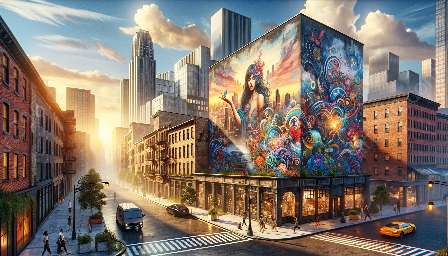Street art has become an integral part of urban landscapes, transforming cities into open-air galleries that reflect the creativity, diversity, and social commentary of the communities they inhabit. This form of artistic expression not only adds visual appeal to the streets but also influences the way people perceive, experience, and interact with their urban environment.
Implications of Street Art on Urban Aesthetics:
Street art offers a platform for artists to address social, political, and cultural issues, sparking thought-provoking conversations within the community. By utilizing public spaces as their canvas, street artists play a significant role in challenging traditional notions of beauty and art, thereby reshaping urban aesthetics. The juxtaposition of vibrant murals, thought-provoking stencils, and visually captivating installations adds a layer of depth and character to urban landscapes, creating a visually stimulating environment that reflects the dynamism and diversity of the city.
- Street art serves as a counterbalance to the monotony of urban architecture by injecting bursts of color, creativity, and unexpected visual narratives into the fabric of the city.
- It encourages the reimagining of urban spaces as interactive, participatory, and inclusive environments that invite engagement and dialogue.
- Street art challenges perceptions of beauty and artistry, broadening the definition of what is aesthetically pleasing and stimulating in an urban setting.
Implications of Street Art on Visual Culture:
Street art has the potential to democratize art by making it accessible to a wider audience. Unlike traditional galleries, street art is free and unbounded, reaching diverse demographics and transcending socio-economic barriers. As a result, it has the power to democratize visual culture, enabling a broader spectrum of voices, narratives, and representations to permeate public spaces.
- It redefines the relationship between art and the public, inviting individuals to engage with and interpret artworks in their everyday surroundings, thus democratizing access to visual culture.
- Street art showcases the multifaceted nature of visual expression, celebrating the intersection of art, activism, and individuality within the public domain.
- It challenges conventional art hierarchies and gatekeeping, allowing emerging artists and marginalized voices to claim their place in the visual landscape of the city.
Conclusion:
In conclusion, the implications of street art in influencing urban aesthetics and visual culture are profound and multifaceted. By reimagining the use of urban spaces as platforms for creative expression, street art has the ability to shape the aesthetic identity of cities and democratize visual culture. The transformative power of street art extends beyond the mere embellishment of walls; it serves as a catalyst for social change, cultural dialogue, and the redefinition of what it means to experience art in the public realm.

